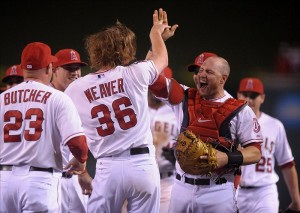Jered Weaver threw the 10th regular-season no-hitter since in the majors since 2010 last night, defined as team pitching performances of at least 9 innings with zero hits allowed. Are no-hitters becoming much more common? Is pitching becoming much more dominant? Click through for some analysis.
There have now been 184 no-hitters dating back to the 1918 season. Note that this figure doesn’t include Roy Halladay‘s NLDS no-hitter or Don Larsen‘s World Series perfect game.
Since the beginning of the 2010 season, there have been 10,448 starts by pitchers and 10 have resulted in no-hitters. That’s a rate of about 1 every 1,045 starts.
From 1918 to 2009, there were 307,008 starts by pitchers and 174 no-hitters. That’s a rate of 1 every 1,764 starts.
So, yes, it seems that no-hitters have been more common in the last few years. However, there are two things to keep in mind:
1) Ten games is still a very small sample size. With a few bloop hits, that number could have been just 7 no-hitters, and the rate would have been 1 no-hitter every 1,493 starts, which is not too different from the historical rate. Something that depends so heavily on a few bloop hits in unlikely to be much more than random chance.
2) The rate of no-hitters should be tied at least somewhat to the overall rate of hitting in the majors. In a low-hitting environment, no-hitters are probably slightly more likely to occur, although they are still so rare as to be quite subject to random fluctuation. Hits per game over 2010-2012 is about 8.7, a much lower figure than during the steroids era when it hovered around 9.2 per game. The last time hits/game was so low was in 1988-1989, but over those two seasons the only no-hitter thrown was Tom Browning‘s perfect game. From 1963 to 1972, though, H/G was below 8.63 every season (and as low as 7.9 in 1968), and there were a whopping 35 no-hitters over than 10-year span. Those came in 34,830 pitching starts, or 1 no-hitter every 995 starts, even more common than what we’re seeing today.
Conclusion? Yes, no-hitters are more common these days, but it’s only because the hit rate is lower than it has been in recent years, and what we’re seeing is consistent with baseball history.

